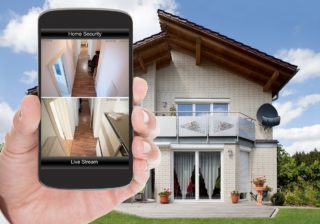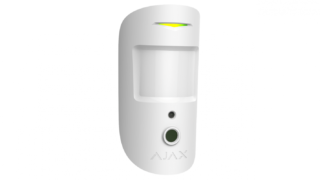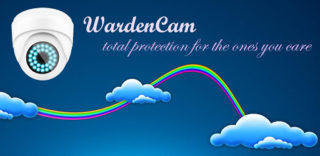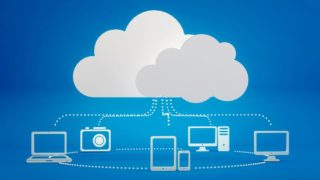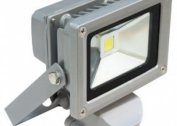The introduction of new technologies by mobile operators allows you to receive streaming video anywhere in the world. Video surveillance for a private home via a smartphone can be organized independently. Real-time control of the situation will not be superfluous for owners of suburban real estate and cottages.
The need for video surveillance
The minimum financial investment needed to connect the camcorder to the phone pays off with the peace of mind of the property owners.
Video surveillance via mobile Internet provides:
- Security of the house and the adjacent plot during the absence of the owners - if an intruder is found, you can quickly come to the cottage, call private security agencies or the police.
- To transmit the results of remote monitoring of the territory in the evening and at night to timely respond to the appearance of unwanted visitors.
- Receiving a signal from a video camera in all rooms of a house, apartment or in any corner of a garden plot.
- Monitoring the behavior of children, hired staff, pets.
- Monitoring the work of employees of the enterprise (office), timely adoption of measures to violators.
Information that video surveillance is being carried out at the facility should be placed at the camera installation sites. The hired personnel and employees of the enterprises are introduced to the information “by signature”.
Features of video surveillance in the country
When installing video surveillance in homes where the user is absent for a long time, it is necessary to take into account the important features of building systems.
Be sure to purchase power supplies with a backup function - when you turn off the power supply, access to video viewing will not stop. Use low-power equipment to save on electricity bills. In addition, this will extend the operating time from the backup power source.
The software and the equipment itself must support the function of switching on command of the motion sensor. Continuous wireless signal transmission over GSM networks to a mobile phone reduces the remaining limits, and getting information from rooms in which the situation does not change is meaningless.
Built-in memory cards will help to recreate the events that occurred if the broadcast on the Internet was interrupted for any reason.
Affordable CCTV technology via mobile Internet
Video surveillance via a smartphone can be organized in various ways. Each of the options will require the correct selection, installation and configuration of equipment.
For private use, it is preferable to choose inexpensive components. Take into account the skills of working with digital devices, if you plan to do it yourself.
Relatively inexpensive options for video surveillance via mobile Internet are:
- direct connection in the camcorder using applications for mobile devices;
- watching videos through cloud services;
- use of broadcast from P2P devices - digital video cameras.
The choice of method depends on the availability of equipment and the quality of the Internet in the place where the broadcast is planned.
Mobile Phone Applications
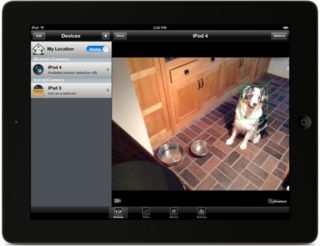
The simplest option to connect a CCTV camera to a mobile phone (smartphone) is to use an old smartphone in video source mode. The owner’s phone, tablet or desktop computer installed at the workplace will receive the signal and show the condition of the facility.
The general algorithm for installing and operating such systems:
- Acquire a paid or download a free application.
- Install programs on the “transmitter” and “receiver” (smartphones, iPhones).
- Connect the "transmitter" and "receiver" to the network of the mobile operator.
- On both devices, they launch the application.
- In the “settings” tab of the receiver, the necessary parameters for streaming video are selected.
- The transmitting smartphone when detecting movement in the visibility range will turn on the video and transmit the signal to the telephone receiver. It can be SMS or a signal in the application.
- The observer, turning on the necessary mode, sees the picture.
Each of the programs has connection and configuration features that must be studied and precisely observed.
Applications typically provide additional features:
- enable recording of what is happening and saving files in the cloud service for 30 days;
- broadcast sound conditions;
- the ability to turn on the "walkie-talkie" mode, which will allow you to broadcast speech through a smartphone-camera, for example, giving a command to pets;
The cost of the programs can be from 6 to 300 dollars. The price depends on the number of connected transmission devices. In addition, the software allows in addition to smartphones (iPhones) to use digital video cameras for broadcasting.
Alfred camera
The program interface is concise and intuitive. You can connect multiple cameras to one transmission channel. The standard features include a motion detector, which starts recording, night mode of operation (with minimal lighting), two-way communication. The manufacturer provides a place on the cloud service for storing records. With the permission of the owner, other users, for example, family members, can watch the recording. The described functionality is free.
Paid subscription involves increased quality of the recorded image and additional space for storing files in the cloud.
Trackview
In addition to the motion detector, a notification has been added to the user about the appearance of noise in the installation area of the camera. Recording will automatically start in both cases (motion and noise). Available viewing included in manual mode. Information is stored on Google Drive.
Subscription frees from viewing ads and blocks private mode.
Athome
A free program with a full range of functions for viewing video transmitted from a smartphone.
For an additional fee, you can install the program on several IP cameras and simultaneously watch the image from them on one mobile gadget. The subscription price includes disk space on the developer’s cloud for storing video files.
Wardencam
The free application has a viewing function in HD mode, which distinguishes the program from competitors.
Records are optionally stored in Google Drive or Dropbox.
In the settings there is a scheduler that allows you to set the time of work by the days of the week. For example, in the evening or on weekends, when the user is at home, you can turn off automatic recording at the command of a motion detector, which will save Internet traffic. This is important when connecting via mobile networks.
Manything
Free mode provides storage of recordings from one smartphone for 30 days on the manufacturer’s cloud.
For a fee, 24-hour recording is available.
The disadvantage of the program is the delay in the image by a few seconds relative to real time, which does not greatly affect the security functions.
Cloud technologies
Most manufacturers of IP cameras provide users with the ability to store and view video on their cloud services. The advantages of this method are its simple setup, which will require minimal programming skills.
The main advantage of cloud technology is that you do not need to acquire a white (static) IP address to identify the camera on the network. Currently, this type of address is provided by mobile operators for an additional fee of 200 to 900 rubles per month. Thus, the cloud-based method of video surveillance is the most affordable in places where the Internet is exclusively mobile (via mobile operators).
Available include the following services:
- IVideon supports its own brand Nobelic cameras and third-party devices from Hikvision.
- YOULOOK supports Axis, HikVision, and Vivotek cameras.
- CamDrive only supports proprietary equipment.
- IPEYE allows you to view the image from your own camera and any others that support the RTSP protocol; Resolution no more than 5M, no need to buy registrars - cameras are connected via routers.
- SpaceCam, created to view RVi cameras (not all models), HiWatch, SpaceCam.
- Ezviz (based on Hikvision), allows the connection of remote motion sensors, door openers, panic buttons.
When choosing a cloud, take into account the features of tariff plans, the cost of cameras and available equipment.
Free features are often limited only to real-time monitoring without archiving. Paid versions of programs differ in functionality, the amount of space on the cloud and the storage time of archived video files.
The configuration and connection is different, but in general terms, the algorithm is as follows:
- They buy cameras, connect them to routers to access the Internet.
- Install the application on a smartphone (iPhone) if it will be used as a camera.
- Register a personal account on a cloud service.
- Prescribe the address and serial number of the camera in the equipment settings. It is possible to use a QR code.
- Click the search button in the cloud program.
- The service finds the camera and establishes a connection. They make additional settings, achieving stable illumination and accurate operation of the motion sensor, at which recording is guaranteed to begin.
The cost of subscriptions changes periodically, sometimes the service provider provides significant discounts - you should carefully study all the offers.
P2P technology
The independent connection of a camcorder for home viewing through a telephone using P2P technology will require the user at least average knowledge in the field of building local networks.
In the general case, the operation of such a system is described as follows:
- Signals from all sources on a local Wi-Fi network are collected by a router, in the settings of which all cameras installed on the site are registered.
- In wired networks, the signal is initially fed to a switch (Switch or Hub) or DVR, where you also need to set the ports of each camera.
- A router or switch connects to the Internet. To work, you need to get static addresses. For providers of fiber-optic networks, it will cost from 20 p. / Month.
- To access the image, it is connected from the phone to the IP address of the router, then to the port of the desired camera.
The method is more suitable for security video surveillance of estates with a large number of cameras.
Connection difficulties
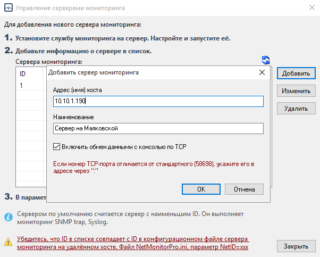
At each stage, unprepared users may have difficulty with the organization of a video surveillance system. They can be divided into problems with the technical capabilities of the equipment and incorrectly selected parameters during configuration.
Difficulties with connecting the camera to the router via Wi-Fi:
- network address and camera address are not registered in the settings;
- the camera does not see the router due to antenna malfunction, weak signal due to long distances or difficult obstacles, Wi-Fi works in stealth mode;
- information exchange protocols do not match;
- in the settings of the router, any restriction is established, for example, by connecting mas addresses, the number of subscribers;
- The camera and router are not on the same network.
Poor communication quality may cause cloud failure.
All equipment must support compatible communication protocols.
Starting to create video surveillance in a private house or in the country, they carefully analyze the tasks and possible technical solutions. Based on the experience and skills of working with IP-equipment. In some cases, they purchase ready-made kits or resort to the help of specialists.
Properly selected and configured equipment will ensure the safety of your home and property, saving the cost of purchasing unnecessary equipment and paying for the Internet.
